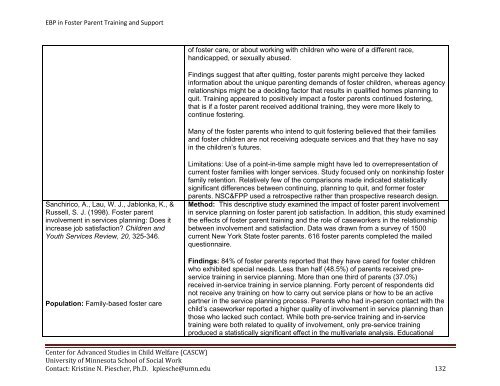Evidence-Based Practice in Foster Parent Training and Support ...
Evidence-Based Practice in Foster Parent Training and Support ...
Evidence-Based Practice in Foster Parent Training and Support ...
Create successful ePaper yourself
Turn your PDF publications into a flip-book with our unique Google optimized e-Paper software.
EBP <strong>in</strong> <strong>Foster</strong> <strong>Parent</strong> Tra<strong>in</strong><strong>in</strong>g <strong>and</strong> <strong>Support</strong>of foster care, or about work<strong>in</strong>g with children who were of a different race,h<strong>and</strong>icapped, or sexually abused.F<strong>in</strong>d<strong>in</strong>gs suggest that after quitt<strong>in</strong>g, foster parents might perceive they lacked<strong>in</strong>formation about the unique parent<strong>in</strong>g dem<strong>and</strong>s of foster children, whereas agencyrelationships might be a decid<strong>in</strong>g factor that results <strong>in</strong> qualified homes plann<strong>in</strong>g toquit. Tra<strong>in</strong><strong>in</strong>g appeared to positively impact a foster parents cont<strong>in</strong>ued foster<strong>in</strong>g,that is if a foster parent received additional tra<strong>in</strong><strong>in</strong>g, they were more likely tocont<strong>in</strong>ue foster<strong>in</strong>g.Many of the foster parents who <strong>in</strong>tend to quit foster<strong>in</strong>g believed that their families<strong>and</strong> foster children are not receiv<strong>in</strong>g adequate services <strong>and</strong> that they have no say<strong>in</strong> the children’s futures.Sanchirico, A., Lau, W. J., Jablonka, K., &Russell, S. J. (1998). <strong>Foster</strong> parent<strong>in</strong>volvement <strong>in</strong> services plann<strong>in</strong>g: Does it<strong>in</strong>crease job satisfaction? Children <strong>and</strong>Youth Services Review, 20, 325-346.Population: Family-based foster careLimitations: Use of a po<strong>in</strong>t-<strong>in</strong>-time sample might have led to overrepresentation ofcurrent foster families with longer services. Study focused only on nonk<strong>in</strong>ship fosterfamily retention. Relatively few of the comparisons made <strong>in</strong>dicated statisticallysignificant differences between cont<strong>in</strong>u<strong>in</strong>g, plann<strong>in</strong>g to quit, <strong>and</strong> former fosterparents. NSC&FPP used a retrospective rather than prospective research design.Method: This descriptive study exam<strong>in</strong>ed the impact of foster parent <strong>in</strong>volvement<strong>in</strong> service plann<strong>in</strong>g on foster parent job satisfaction. In addition, this study exam<strong>in</strong>edthe effects of foster parent tra<strong>in</strong><strong>in</strong>g <strong>and</strong> the role of caseworkers <strong>in</strong> the relationshipbetween <strong>in</strong>volvement <strong>and</strong> satisfaction. Data was drawn from a survey of 1500current New York State foster parents. 616 foster parents completed the mailedquestionnaire.F<strong>in</strong>d<strong>in</strong>gs: 84% of foster parents reported that they have cared for foster childrenwho exhibited special needs. Less than half (48.5%) of parents received preservicetra<strong>in</strong><strong>in</strong>g <strong>in</strong> service plann<strong>in</strong>g. More than one third of parents (37.0%)received <strong>in</strong>-service tra<strong>in</strong><strong>in</strong>g <strong>in</strong> service plann<strong>in</strong>g. Forty percent of respondents didnot receive any tra<strong>in</strong><strong>in</strong>g on how to carry out service plans or how to be an activepartner <strong>in</strong> the service plann<strong>in</strong>g process. <strong>Parent</strong>s who had <strong>in</strong>-person contact with thechild’s caseworker reported a higher quality of <strong>in</strong>volvement <strong>in</strong> service plann<strong>in</strong>g thanthose who lacked such contact. While both pre-service tra<strong>in</strong><strong>in</strong>g <strong>and</strong> <strong>in</strong>-servicetra<strong>in</strong><strong>in</strong>g were both related to quality of <strong>in</strong>volvement, only pre-service tra<strong>in</strong><strong>in</strong>gproduced a statistically significant effect <strong>in</strong> the multivariate analysis. EducationalCenter for Advanced Studies <strong>in</strong> Child Welfare (CASCW)University of M<strong>in</strong>nesota School of Social WorkContact: Krist<strong>in</strong>e N. Piescher, Ph.D. kpiesche@umn.edu 132
















